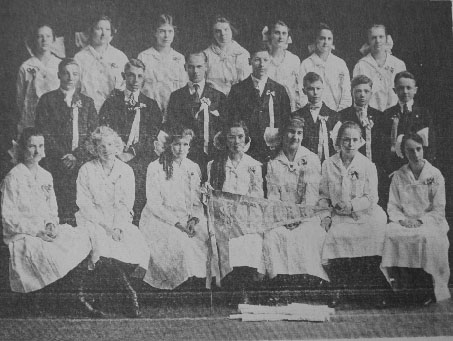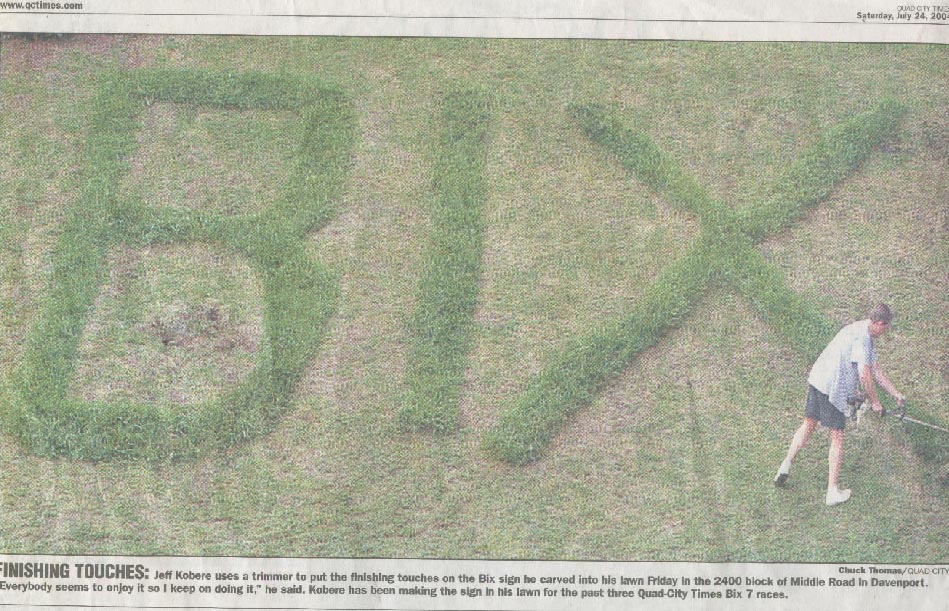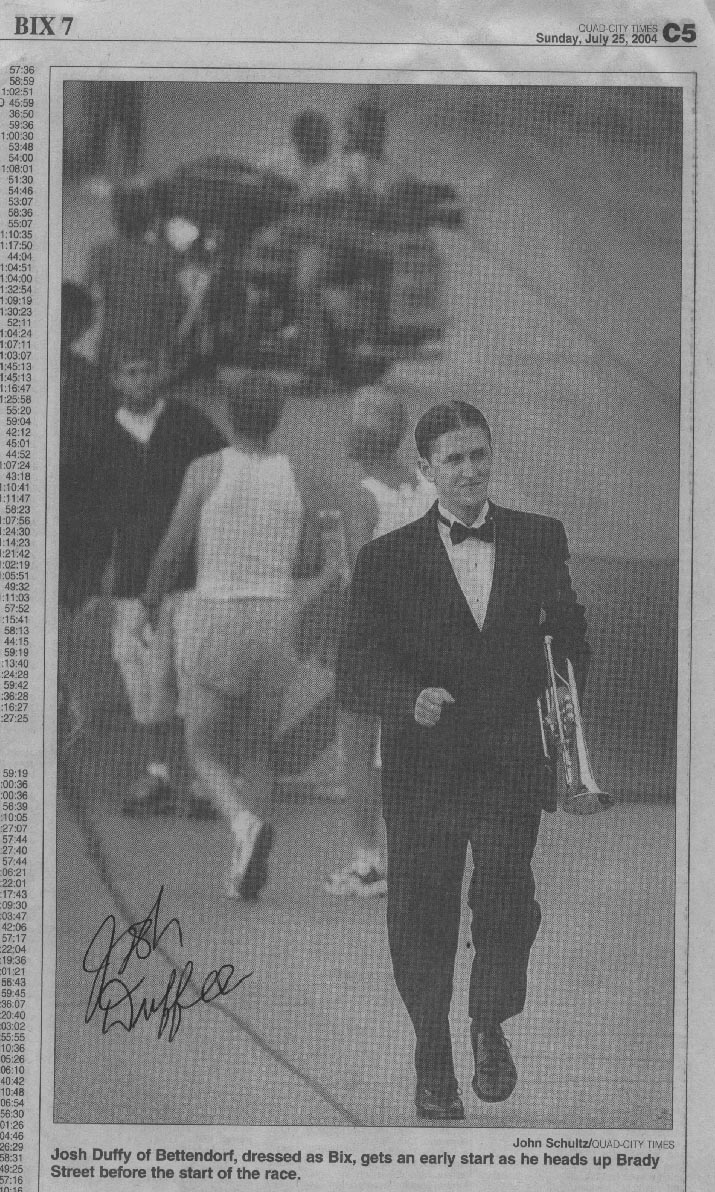
Eigth Grade class, Tyler School, Davenport, Iowa, school year 1918-1919
Vera Cox is third from left in front row. Bix is first from right in second row.
German
American
Heritage
Center
It is located at 712 West
Second Street in Davenport, Iowa, at the foot of the Centennial Bridge,
in a three-story building, built in 1863, which served as a hotel or
"Gast
Haus." German immigrants who came to settle in the Davenport area and
pioneers
who stopped in Davenport on their way further west stayed in this
hotel.
It was first known as the Germania Haus and later as the Miller Hotel.
The center was founded in 1994 and is dedicated to preserving the
German
Heritage in the Quad City region.
I spent a
couple of
hours
on July 23, 2004 visiting the center, looking at the exhibits, and
talking
to Amy Driskill, the Executive Director of the Center. Ms. Driskill was
the most gracious hostess and provided a lot of information about the
center.
The exhibit which attracted my attention was, of course, the Bix
exhibit.
It consists of text and photos. There is a Bix timeline. There are
photographs
of Bix's family, of Bix, and
of some of the bands he played with. Here is a photo of the wall
with the information and photos. The recently discovered high
school photo is included in the exhibit.
There is a concise
account of Bix's life entitled "Truth, Myth & Legend." It is well
written
and accurate. Through the courtesy of Ms. Driskill, the complete text
follows.
Although
Vera was over
a
year younger than Bix (she was born on August 27, 1904), Vera and Bix
were
classmates beginning in 1912 in elementary shcool, and continuing
through
high school. We know that Bix contracted scarlet fever and missed
school
most of the 1911-1912
school year. Thus, when
he enrolled in third grade (for the second time; the first time was on
September 4, 1911) on September 2, 1912, Vera was in the same
class.
Six years later, Vera and Bix are seen in the the photo of the Tyler
School
eigth grade class.

Eigth Grade class, Tyler School, Davenport, Iowa, school year 1918-1919
Vera Cox is third from left in front row. Bix is first from right in
second row.
Vera lived in her grandmother's house on Iowa Street, a few blocks from Grand Avenue. Bix would come and visit Vera, but instead of talking to her, he played the piano in the house. According to Vera, Bix had a peculiar way of playing piano: his fingers were stiff. He spent hours playing chords, engrossed in his music. Often, Bix's mother would call and ask if Bix was there. If he was, she would ask that he be sent home because dinner was ready. In a similar vein, whenever Bix would take Vera on a date, while he was very much smitten with her, in a musical situation, he would gravitate towards his real true love, music.
John related an amusing anecdote about Bix. In 1930, when Vera was visiting her parents in Davenport with her six-month old son John, Bix went to visit her. He knew that Vera had a son, and, as a courtesy, Bix brought a sac of peanuts (!) for little John. We know of Bix's fondness for peanuts, but obviously Bix had not been around babies and had little notion of what a six-month old baby could eat.
Other items of great interest related by John and John, Jr. follow.
The orchestra was in the auditorium at 7 pm and started with a rehearsal of some Bix tunes -"I'm Coming Virginia," "Since My Best Gal Turned Me Down," (a new arrangement by Frank van Nus in the style of Bill Challis), and "I'll Be A Friend With Pleasure." Around 7:30 the formal portion of the event began. The best way I can describe it is as a "Historical Concert." Josh gave a chronological/musical account of the Jean Goldkette Orchestra. Before each number the orchestra played, Josh provided an explanation of the number and its context in terms of the musical evolution of the Goldkette orchestra. It was a lesson in history and in music. The Josh Duffee Orchestra gets better and better every year. Now it is a true orchestra, tight, well- rehearsed, professional. The orchestra provides a terrific emulation of the sound of the Goldkette band. Although the musicians in the band (four reeds, three trumpets, two trombones, string bass, drums, xylophone, violin, guitar/banjo and flute) read their parts, they do so in such a manner that the sound they create sounds fresh, spontaneous, new. The orchestra started with "In the Evening," the first recording of the Goldkette orchestra in 1924. They continued, in an illustration as to how the orchestra evolved, with "It's the Blues," "Dinah," "Blue Room," (a number played but not recorded by Goldkette). The orchestra went on with a series of numbers recorded by the Goldkette Orchesta with Bix: "Idolizing,", "I'm Looking Over A Four Leaf Clover," "Proud of a Baby Like You," Hoosier Sweetheart," Stampede," "Tiger Rag" (the last two tunes were played but nor recorded by Goldkette), "In My Merry Oldsmobile." Thje orchestra ended with a rousing version of "My Pretty Girl Stomp" and the Bix-Goldkette classic, "Clementine." The audience was highly appreciaive of the great performance by this band of young people. playing -superbly and expertly- very old music.
Before the second band came in, the Goldkette Foundation Award was presented. For the last several years, Alann Krivor, grandnephew of Jean Goldkette and chairman of the Godlkette Foundation, has honored individuals who have contributed to the preservation and dissemination of the Jean Goldkette musical legacy. The Goldkette Foundation Award consists of a framed baton and the reading during the "AfterGlow" of a citation describing the contribution of the awardee. The award was presented -in absentia- to Hans Eekhoff, Dutch Bixophile, record collector, and CD producer and sound engineer for Timeless. The award was highly deserved in view of Hans' generous support of the Bix Society and his vigorous and effective activities in connection with the restoration and world premiere in Davenport on June 6, 2004 of the Jean Goldkette On Tour 1926 film in custody of the Jazz Museum in New Orleans. Josh Duffee read the citation and Albert Haim accepted the award on behalf of Hans Eekhoff. The citation reads as follows.
"To all of you………………the audience, contributors, volunteers, and musicians
It is with deep regret that Mali and I are unable to attend this year's Bix. We always enjoy the company of all of you, who so unselfishly, attend and make the Bix such a superb musical event.
Mali and I together with the Goldkette Foundation thank all of you for the support you have given music in the Jean Goldkette tradition. I know that if Jean were still with us, he would want to thank each and everyone of you personally for keeping his dream alive through Bix Beiderbecke and this Festival.
In spirit, I thank you for Jean Goldkette and his Foundation.
The Jean Goldkette Baton award for 2004 should be given to all of you who have worked so hard each year to make the Bix a roaring success, and that includes each of you in the audience. Unfortunately, we must select just one. In the past the Goldkette baton has been awarded to the Bix Society, Spiegle Willcox, Trevor Rippingale and the Wolverines, the Josh Duffee Orchestra, and in 2003 - Frank Van Nus.
This year a person came to our attention who has offered considerable support to the Bix, the Society and the Goldkette tradition. His contribution has been both financial and active support of bringing forth information to the attention of everyone associated with the Bix Festival.
In 2004 the baton award for his support of music in the Jean Goldkette tradition goes to Hans Eckoff of the Netherlands. The award is not only for his financial support, but also for his rescue and reproduction of the film of the Goldkette Orchestra on tour in 1926.
I've asked Josh Duffee as the 2002 recipient to present this award to Hans tonight.
Thank you all,
Alann Krivor
Chair"
Images of
the 2004
Bix
Festival.




Sue's
last name is misspelled: it should be Fischer